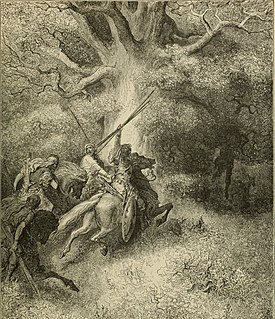Battle of the Wood of Ephraim
| Battle of the Wood of Ephraim | |||||||
|---|---|---|---|---|---|---|---|
| Part of Absalom's Revolt | |||||||
 Relief of Joab (front rider) riding on a horse to put an end to Absalom's princely rebellion | |||||||
| |||||||
| Belligerents | |||||||
| Forces of King David | Forces of Absalom | ||||||
| Commanders and leaders | |||||||
|
Ittai |
Absalom † Amasa | ||||||
| Casualties and losses | |||||||
| Unknown; Light | Unknown; Heavy | ||||||
According to
Scholarly opinion is divided as to the historicity of the events in the Books of Samuel. Most scholars believe that the Books of Samuel contain a large amount of historical information, while there are some dissenters who view them as entirely fictional.[2]

Background
Absalom, the third son of King David of
Location
The
Battle
Absalom initiated the attack with his forces. He chose Amasa, one of Joab's kinsmen, as general, and marched out of Jerusalem into the land of Gilead. When David entered Mahanaim with his forces, as a result of his fame many warriors flocked to his aid, and passed before him to the battle,[14] as he stood at the gate of the city. David divided the army into three parts—one was to be led by Joab; one by Abishai; and the third by Ittai, the trusted friend and commander from Gath.
David then declared that he would head the army himself, but his soldiers would not allow David to risk his life. They asked him to remain in the city. When all was ready, David gave to the three Generals this parting injunction, "Deal gently, for my sake, with the young man, with Absalom." The two armies met in a forest of Ephraim. It was a great and terrible battle. The rebel forces were unable to maneuver because the thickness of trees, and their numbers were reduced by the underbrush of the forest.[15] The forces of Absalom were thus routed by the royal forces of David.
Absalom himself fled. As he was riding through the woods on his mule, he was caught by the long locks of his hair under the spreading branches of a large tree. Unable to free himself, he remained suspended, his mule had escaped. One of David's servants brought this intelligence to General Joab, who gave the order that Absalom be put to death and the royal troops disengaged immediately thereafter.
See also
References
- ^ LITERATURE. See the commentaries on the books of Samuel, Kings, Chronicles, and Psalms, and histories of the kingdoms of Israel and Judah, especially Wellhausen and Kittel. A sketch of the life and historical position of David from the modern Continental point of view will be found in G. Beer, Saul, David, Salomo, published by Mohr, Tubingen, 1906.
- ISBN 978-0-88414-075-7.
- ^ 2 Samuel 14:21, 14:23–24
- ^ 2 Samuel 15:1–5
- ^ 2 Samuel 15:6
- ^ 2 Samuel 15:9–10
- ^ 2 Samuel 15:13
- ^ 2 Samuel 15:14–15
- ^ "Espionage and the Jews". Haarezt. Elon Gilad. Nov 12, 2013.
- ^ 2 Samuel 15:27–29, 15:34–36
- ^ 2 Samuel 17:24
- ^ 2 Samuel 17:26
- ^ "Forest of Ephraim".
- ^ "David". www.Bibler.org.
- ^ 2 Samuel 18:8 NIV

